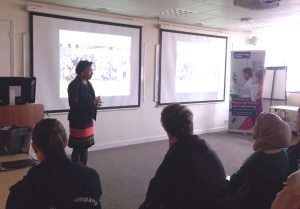
Diabetic wound healing (Koch Institute for Integrative Cancer Research)

Last week IMSE welcomed Professor Paula Hammond from MIT to give the final Highlight Seminar in the 2016/2017 series.
During a two-day visit to the Institute for Molecular Science and Engineering (IMSE), kindly sponsored by BASF, Professor Paula Hammond – Head of the Department of Chemical Engineering and the David H. Koch Chair Professor in Engineering at the Massachusetts Institute of Technology (MIT) – spoke to an audience of more than 100 people from all reaches of the College.
Seeing so many people from all over college was a great way to end a fantastic series of seminars.
– Rebecca Blaylock
IMSE Institute Manager
Her lecture, entitled “Nanolayered drug-release systems for regenerative medicine and targeted nanotherapies”, illustrated the wide applicability of her work to important ongoing health problems.
Intrinsically interdisciplinary
Professor Hammond is a polymer scientist and chemical engineer by training, but her career’s work has spanned many more disciplines. Her success is real evidence of the power of the holistic molecular science and engineering approach – by blurring the boundaries between scientific and engineering disciplines, final function and end-use requirements become an integral part of the underlying scientific research.
Right from the beginning of my career I didn’t see boundaries, just the work that needed to be done.
– Professor Paula Hammond
David H. Koch Chair Professor of Engineering, Massachusetts Institute of Technology
Indeed, Professor Hammond’s interdisciplinarity is widely recognised and she was awarded the US Department of Defense Ovarian Cancer Teal Innovator Award in 2013. This award supports a visionary individual from any field, outside of ovarian cancer, to focus their creativity, innovation and leadership on ovarian cancer research.
Programmed drug delivery
The work conducted in Professor Hammond’s laboratory – part of the MIT Koch Institute for Integrative Cancer Research – is largely based around ‘layer by layer’ self-assembly of multifunctional polymeric nanomaterials, for a number of different purposes.

Professor Paula Hammond
The team’s overarching aim is to design programmable material systems so that one or more drugs can be delivered – with temporal and spatial control – to target specific functions and processes.
In her talk, Professor Hammond presented several examples of her group’s success with this approach. For instance, the layer by layer technique can be used to promote bone growth in situations where large gaps exist because of birth defects or trauma.
In addition, nanoparticles designed with the layer by layer approach can be used to tackle advanced forms of cancer. The controlled release of multiple agents – such as small interfering RNA (siRNA) – can be optimized to cause cancer cell death.
Another application of the technique is the design of self-assembled biomaterials for modulating the healing of chronic wounds, including ulcers experienced by diabetes patients. This work was the focus of a collaboration with IMSE Affiliate Dr Ben Almquist during his time as a postdoctoral fellow in Professor Hammond’s team.
Coming up at IMSE
After a very busy start to spring for the Institute, IMSE’s programme of events will continue with a workshop on the future of additive manufacturing (contact Rebecca Blaylock to register your interest) on 24th May, and a Lunchtime Seminar on Wednesday 7th June.
Article text (excluding photos or graphics) © Imperial College London.
Photos and graphics subject to third party copyright used with permission or © Imperial College London.
Reporter

Dr Shoshana Z Weider
Faculty of Engineering

Contact details
Email: press.office@imperial.ac.uk
Show all stories by this author



